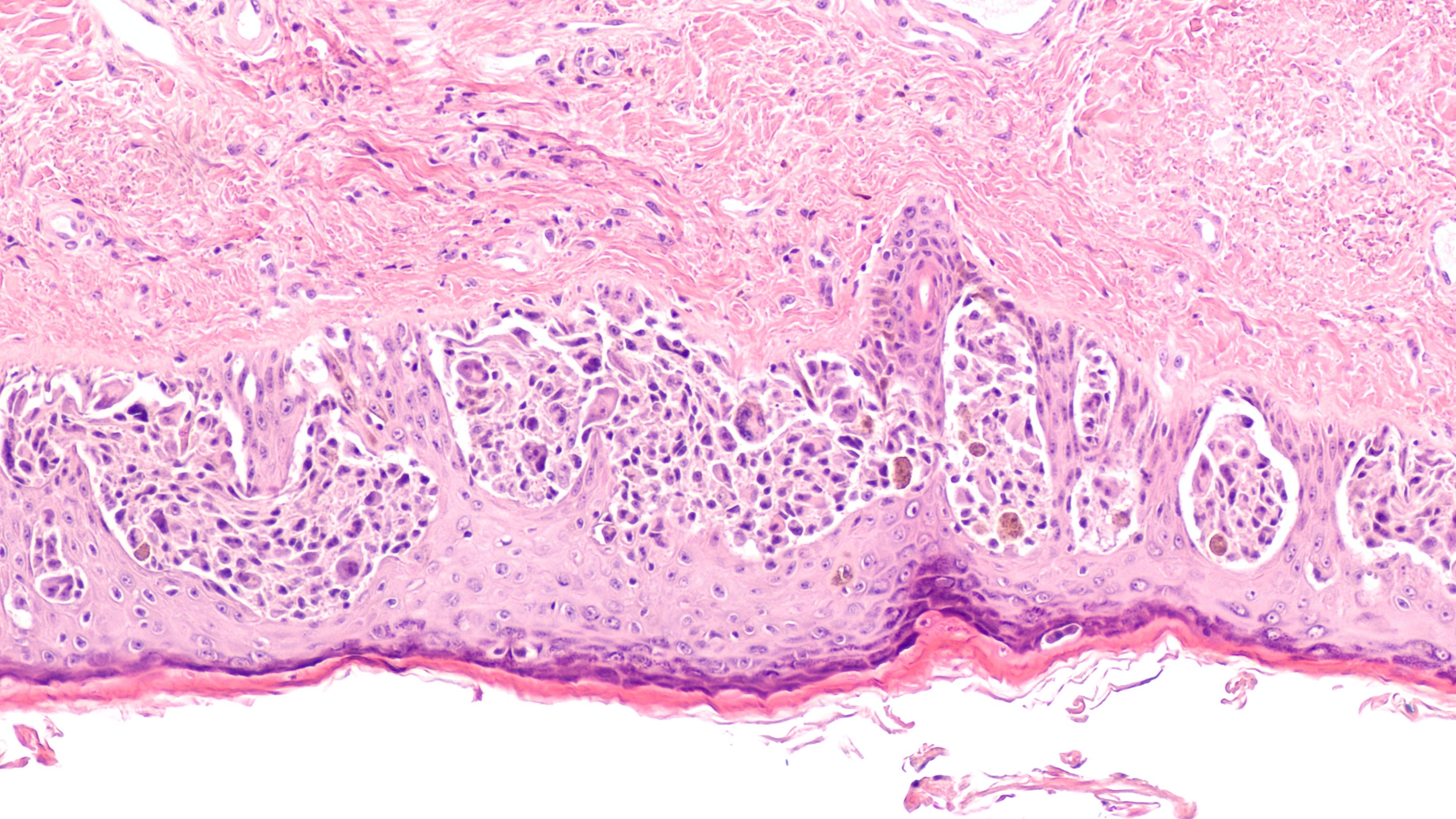mRNA-4157 Plus Pembrolizumab Continues to Improve RFS in High-Risk Melanoma
Findings from 3-year follow-up of KEYNOTE-942/mRNA-4157-P201 show that the cancer vaccine mRNA-4157 plus pembrolizumab reduced the risk of recurrence or death in patients with stage III/IV melanoma following resection.
Melanoma: © David A Litman - stock.adobe.com

Planned 3-year follow-up of the KEYNOTE-942/mRNA-4157-P201 study (NCT03897881) evaluating adjuvant treatment of mRNA-4157 (V940), an investigational cancer vaccine, plus pembrolizumab (Keytruda) found that the combination continued to confer a clinically meaningful benefit in recurrence-free survival (RFS) and reduced the risk of recurrence or death by 49% (HR, 0.501; 95% CI, 0.288-0.906; one-side nominal P =.0095) in patients with stage III/IV high-risk melanoma who underwent complete resection.1
The combination also continued to improve distant metastasis-free survival (DMFS) and reduced the risk of distant metastasis or death by 62% (HR, 0.384; 95% CI, 0.172-0.858, one-sided nominal P =.0077) compared with pembrolizumab alone.
“As we continue to follow participants in the KEYNOTE-942/mRNA-4157-P201 study, we are excited to see such a robust clinical benefit with mRNA-4157 as adjuvant treatment in combination with [pembrolizumab] in people with resected high-risk melanoma,” said Kyle Holen, MD, senior vice president and head of development, Therapeutics and Oncology, Modern, in a press release. “These data add another positive analysis to the multiple end points and subgroups previously assessed in this study. Importantly for this technology, the KEYNOTE-942/mRNA-4157-P201 study was the first demonstration of efficacy for an investigational mRNA cancer treatment in a randomized clinical trial and the first combination therapy to show a significant benefit over [pembrolizumab] alone in adjuvant melanoma.”
The safety profile of the combination was consistent with what has been previously observed. The incidence of grade 3 or higher adverse events (AEs) was similar between the mRNA-4157 with pembrolizumab vs pembrolizumab alone arms, at 25% and 20%, respectively. The most common any-grade AEs attributable to mRNA-4157 were fatigue (60.6%), injection site pain (56.7%), and chills (49%).
In February 2023, the FDA granted breakthrough therapy designation to mRNA-4157 with pembrolizumab in this intent-to-treat population.2 Findings from an 18-month follow-up of the KEYNOTE-942 study were presented at the 2023 European Society for Medical Oncology Congress and showed an RFS improvement with a 44% reduction in risk of death or recurrence with the mRNA-4157/pembrolizumab combination compared with pembrolizumab alone (HR, 0.561; 95% CI, 0.309-1.017; P =.266).3
About KEYNOTE-942
KEYNOTE-942 is a phase 2 randomized study of mRNA-4157 plus pembrolizumab vs pembrolizumab alone following complete resection of high-risk melanoma. The study is still enrolling and has an estimated enrollment of 257 patients across 16 locations in the United States and 5 locations in Australia.4
The primary end point is RFS, and this will be evaluated up to 5 years. The secondary end points are DMFS, number of participants with AEs, and number of participants who discontinue treatment due to AEs.
In the experimental arm, patients receive up to 9 doses of mRNA-4157 every 21 days along with pembrolizumab every 21 days until disease recurrence or unacceptable toxicity, or until patients have received up to 18 total cycles of treatment. In the active comparator arm, patients receive pembrolizumab every 21 days, with the same criteria for discontinuation.
Patients are eligible to participate if they have resectable cutaneous melanoma metastatic to a lymph node with high recurrence risk, underwent complete resection within 13 weeks of the first pembrolizumab dose, normal organ and marrow function, and an ECOG performance status of 0 or 1. Patients are excluded from the study if they have a prior malignancy, have received prior systemic anti-cancer treatment, have received a live vaccine within 30 days of treatment initiation, have an active autoimmune disease, prior interstitial lung disease, or an active hepatitis B or C or HIV infection.
REFERENCES:
1. Moderna and Merck announce mRNA-4157 (V940) in combination with Keytruda (pembrolizumab) demonstrated continued improvement in recurrence-free survival and distant metastasis-free survival in patients with high-risk stage III/IV melanoma following complete resection versus Keytruda at three years. News release. Merck. December 14, 2023. Accessed December 18, 2023. https://tinyurl.com/mwj5sny8
2. Moderna and Merck announce mRNA-4157-V940, an investigational personalized mRNA cancer vaccine, in combination with Keytruda (pembrolizumab), was granted breakthrough therapy designation by the FDA for adjuvant treatment of patients with high-risk melanoma following complete resection. News release. Merck. February 22, 2023. Accessed December 18, 2023. https://tinyurl.com/45xe7j58
3. Weber JS, Khattak A, Carlino MS, et al. mRNA-4157 (V940) individualized neoantigen therapy + pembrolizumab vs pembrolizumab in high-risk resected melanoma: clinical efficacy and correlates of response. Presented at the 2023 European Society of Medical Oncology Congress, October 20-24, 2023. Madrid, Spain. Abstract LBA49.
4. An efficacy study of adjuvant treatment with the personalized cancer vaccine mRNA-4157 and pembrolizumab in patients with high-risk melanoma (KEYNOTE-942). ClinicalTrials.gov. Updated December 13, 2023. Accessed December 18, 2023. https://www.clinicaltrials.gov/study/NCT03897881
Similar Efficacy in Melanoma Shown in Indirect Comparison of PD-1/LAG3 vs PD-1/CTLA-4
July 16th 2024During a Case-Based Roundtable® event, Michael A. Postow, MD, discussed an indirect treatment comparison of nivolumab plus relatlimab vs nivolumab plus ipilimumab in patients with advanced melanoma in the first article of a 2-part series.
Read More
EFS Benefit of Pembrolizumab Is Shown in Neoadjuvant, Adjuvant Setting
June 27th 2024Douglas B. Johnson, MD, MSCI, offers a comprehensive exploration of the nuances for using neoadjuvant therapy, addressing various treatment combinations, along with recommendations for first-line systemic therapy.
Read More